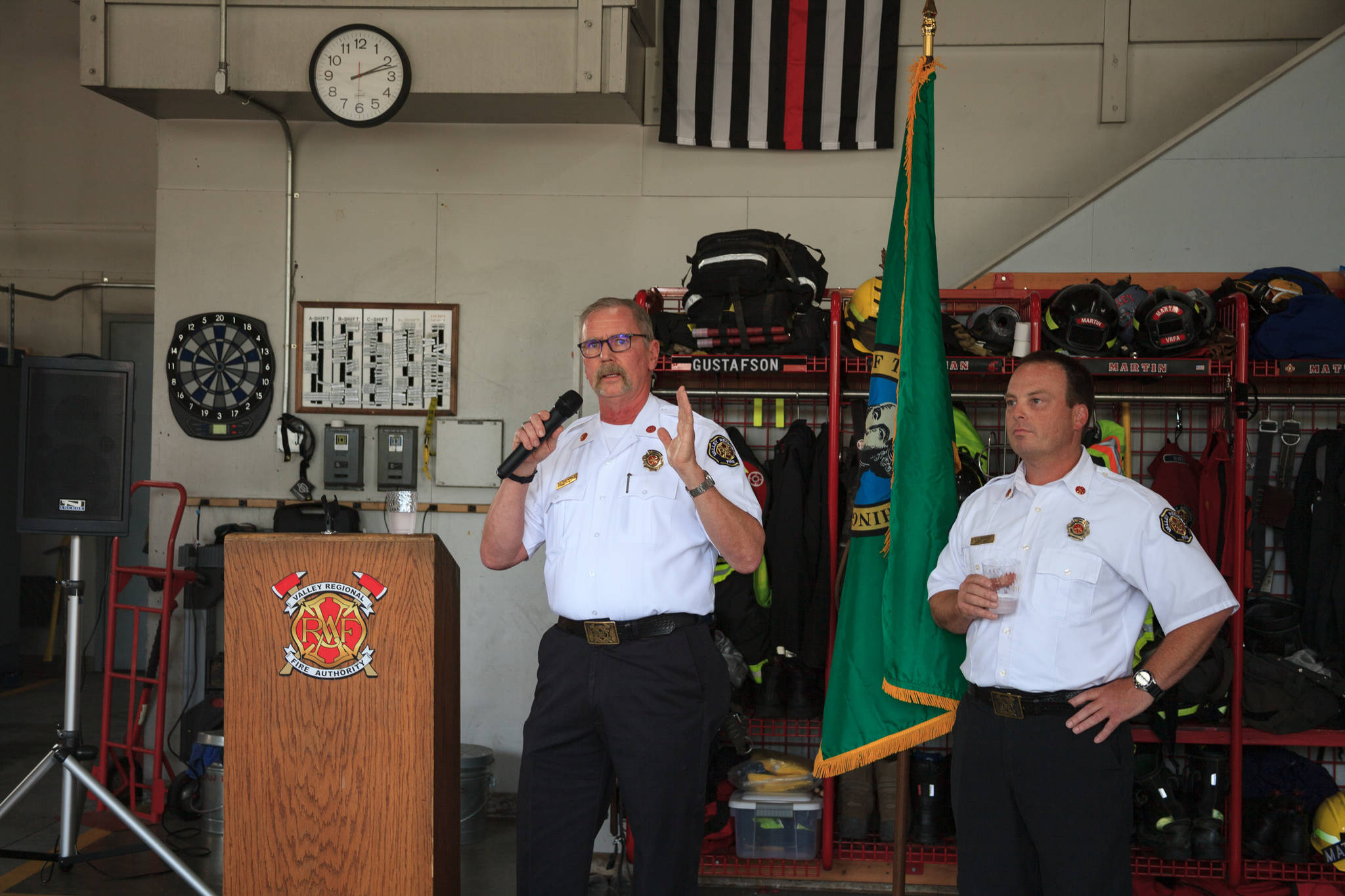Valley Regional Fire Authority Chief Brent Swearingen retired and passed the torch to VFRA’s new chief, Brad Thompson, during a change of command ceremony on Aug. 5.
Swearingen joined the VRFA in 2012 after leaving the Reno Fire Department where he worked since 1984, according to VRFA. Swearingen joined the VFRA as Deputy Chief of Operations in January 2012.
Swearingen accepted the position of fire chief in 2019 and developed plans to improve the department by updating policies and goals as well as purchasing a new ladder truck and land to build new fire stations.
With those plans set in motion, Swearingen felt he accomplished what he set out to do and is ready for retirement, according to the department.
“I believe we have set a clear direction and succession plan that will carry the organization forward,” Swearingen said in a press release. “One that our employees, governance board, and the community can support.”
During the change of command ceremony on Aug. 5, Swearingen delivered a heartfelt speech to his family, friends and firefighters from a podium set up in Station 31. Swearingen thanked his colleagues at the fire department, the union and board and his family for what he called “the ride of a lifetime.”
Swearingen also gifted the VFRA with a 19th century brass firefighters speaking trumpet, which was used by the person in charge during a fire as a token of respect to the department and new chief. Today, pins in the shape of the speaking trumpet are used to identify a firefighter’s rank.
After giving his speech, Swearingen handed Thompson his badges before Thompson took to the podium and spoke about Swearingen’s time at the VFRA and how he plans to build off of what the outgoing chief accomplished.
“When we’re faced with adversity, we wish we had a crystal ball so that we could see what the future has for us,” Thompson said. “We always want that right guy, we want to put him in the right place at the right time, I believe that’s what happened with Chief Swearingen. Nobody knew we were going to be faced with a once in a lifetime pandemic, but the leadership, the steady hand that he has displayed throughout that, for all of us, I think there’s no way we could thank him enough.”
Swearingen oversaw the wildland fire program, the creation of their standard of cover, the strategic plan, capital facilities plan, policy rewrites, and the purchase of a new ladder truck during his two years as chief, Thompson said.
Despite those tangible accomplishments, Swearingen said the thing he’s most proud of is the trust VRFA firefighters built and the pride they take in their work.
“We got a lot of ‘stuff’ done, but enhancing the trust, enhancing the level of professional pride, that’s what I’m most proud of,” Swearingen said.
Although he is retiring, Swearingen said he’s not going away anytime soon. He plans to continue working in the community through volunteering at the food bank and the Kiwanis Club.
“I really love this community, it’s a great community. I love its spirit, so I’m gonna keep doing volunteer work here, ” Swearingen said.
New chief
Thompson said he’s excited to become the new chief and that he plans to get the VRFA accredited, build new fire stations and make improvements to their existing facilities during his tenure.
“In the immediate future, we have what’s called accreditation, where you do a self assessment of your fire department,” Thompson said. “Then some outside experts come in from all over the country and they confirm your assessment and tell you where you need to go. We’ll find out in October if we get accredited and join that really elite group of fire departments from across the country.”
In the longer term Thompson will work to accomplish the department’s capital facilities plan –– building new stations and improving the old ones.
Fire Station 31, where the ceremony was held, is the VRFA headquarters built in 1983, and was only designed for 25 years of life. Station 31 is one of five VRFA stations, yet it handles one third of the calls, Thompson said.
“We’re getting to the point where, in order to serve our community well, we need to spread out our resources,” Thompson said. “So we’re evaluating properties up north where we could staff a fire engine to take some of the pressure off of this fire station so we can still get to the calls around here in a reasonable time frame.”
The VRFA also operates out of a building in the Pacific-Algona area that is shared with Pacific police. That building, like Station 31, is well beyond its lifespan, Thompson said.
Getting all of those things accomplished is going to take some time, but Thompson is ready for the challenge ahead.



